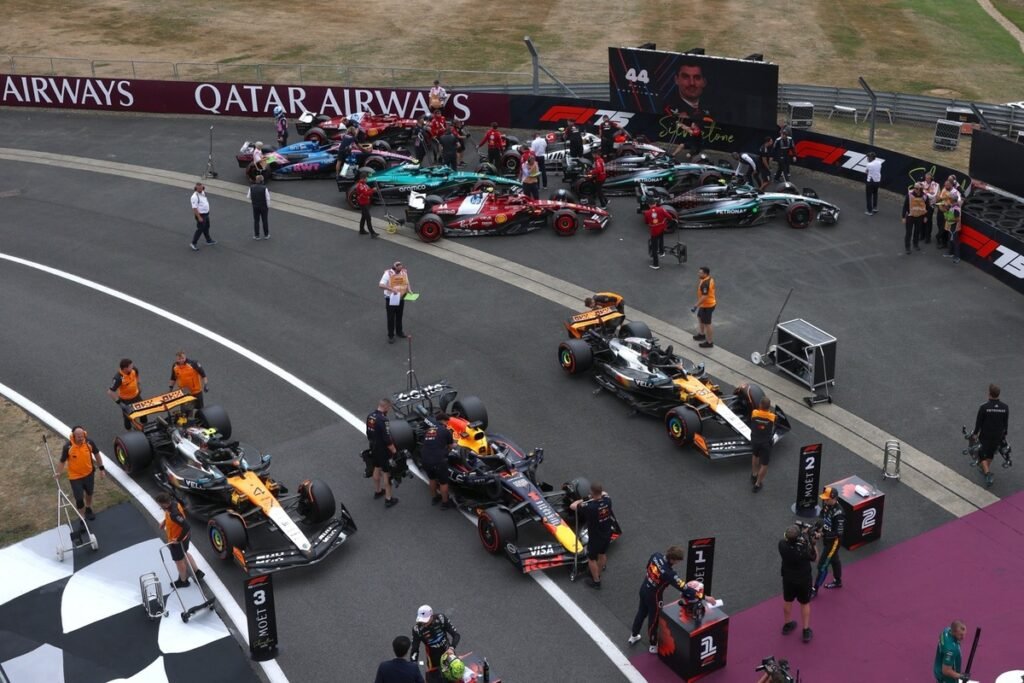Strategic Set-Ups and the Battle for Pole Position
The qualifying session for Formula 1’s British Grand Prix was a thrilling display of speed and strategy, with the top six cars separated by just 0.229 seconds in Q3. What made this session even more intriguing was the variety of set-up choices that teams employed to achieve their results. Each team had its own approach, reflecting different priorities and philosophies about how to maximize performance on the Silverstone circuit.
Diverse Approaches to Performance
The Ferrari cars of Charles Leclerc and Lewis Hamilton demonstrated strong performance in high-speed corners but struggled on the straights. In contrast, Red Bull’s polesitter Max Verstappen opted for a low-downforce wing configuration, transforming his RB21 into a straightline rocket. However, this choice came at the cost of reduced performance in the more demanding corner sequences. McLaren’s Oscar Piastri and Lando Norris found themselves somewhere between these two extremes, balancing speed in both areas.
Verstappen explained that the decision to use a lower-downforce setup was necessary after experiencing significant understeer during Friday’s practice sessions. This trait, which he strongly dislikes, forced the team to adjust the car’s balance. By reducing rear downforce, Red Bull managed to improve the car’s handling, allowing Verstappen to gain more grip in the twistier sections of the circuit and prevent the McLarens from securing pole position.
Balancing Speed and Tyre Management
Verstappen acknowledged the unique characteristics of each team’s performance. He noted that Ferrari is exceptionally quick in the corners but slower on the straights, while McLaren sits somewhere in the middle. For Red Bull, the focus is on straightline speed, even if it means sacrificing some performance in the corners.
“Everything will depend on who can keep their tyres alive during the stint,” he said. “I hope for an exciting race involving many teams.”
The question remains: will Verstappen’s low-downforce setup affect his tyre wear? Will we see a repeat of the Japanese Grand Prix, where faster McLarens were unable to overtake him? Or will the increased tyre wear at Silverstone cause Verstappen to burn through his tyres too quickly?
The Impact of Reduced Downforce on Tyre Wear
Despite being the fastest on the straights, Verstappen believes that his current setup might actually help manage tyre temperatures. “We just need to make sure the front tyres don’t overheat,” he pointed out. “That’s generally a big issue for us. Maybe the setup we have now will help with that.”
McLaren team boss Andrea Stella is aware of the challenge posed by Verstappen’s performance. He believes that the Dutchman is a serious contender for victory at the British GP. Stella also highlighted that there may not be a clear relationship between downforce levels and tyre wear at Silverstone.
“If you’re fast on the straights, you may actually need to push less in the corners,” he explained. “If you rely on lap time generated in the corners, you might stress your tyres more. It’s not clear whether Red Bull’s rear wing solution will necessarily lead to worse tyre conditions.”
Weather Uncertainties
The possibility of rain adds another layer of complexity to the race. Although the morning skies in Northamptonshire opened up, the forecast suggests that the weather will clear by the time the race starts at 3pm. Verstappen acknowledged the importance of weather conditions, stating that straightline speed is beneficial, but managing tyres remains crucial at Silverstone.
“If it dries up, the net benefit for Red Bull and other teams like Mercedes, who are currently behind the frontrunners, could be cooler temperatures that help Pirelli’s tyres perform better,” said Red Bull advisor Helmut Marko. He also emphasized that Verstappen’s impressive long-run pace on Friday was a key factor in their confidence heading into the race.
Conclusion
As the teams prepare for the British Grand Prix, the strategic decisions made during qualifying will play a critical role in determining the outcome. With varied set-ups and the potential impact of weather conditions, the race promises to be a fascinating contest. Whether it’s the straightline speed of Red Bull, the balanced approach of McLaren, or the cornering prowess of Ferrari, all teams will need to adapt and manage their resources effectively to come out on top.

